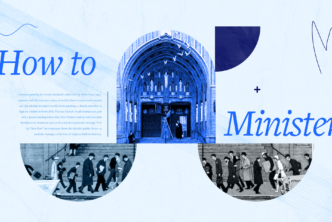I recently addressed a gathering of church leaders about the “Everlasting Gospel for Gen Z.” When I finished speaking, a long line of people formed to ask questions. That wasn’t strange or unusual. What was strange was that they all asked me versions of the same exact question: “How do I get my kids to look away from their phone and engage?”
This question has lots of layers and possible responses. I want to address one layer, which is how we engage with young people when we talk about the Bible.
I have identified nine practices that help adults and young people interpret the Bible together.
1. Commit to learning alongside young people
Kevin Vanhoozer highlights two common sins of the interpreter: pride and sloth.1
For many older individuals, reading the Bible alongside young people demands humility. Pride can occur when an older person’s interpretation is automatically prioritized over that of the younger person, potentially overshadowing their insights. Crucially, as we approach the text alongside young people, we must do so with humility, recognizing them as God’s image-bearers prioritized by Jesus (Gen 1:27; Matt 19:14).
As we approach the text alongside young people, we must do so with humility, recognizing them as God’s image-bearers prioritized by Jesus.
Sloth manifests in the temptation to take the easier route of telling young people what the Bible means instead of engaging in a joint exploration. Reading the Bible with young people might seem less efficient and more labor-intensive, but it is essential for fostering mutual understanding and growth.
Engaging young people in this manner often means stepping out of one’s comfort zone and being willing to admit that you don’t have all the answers. This vulnerability can be powerful, modeling a genuine search for truth and an openness to learning from others, regardless of age.
By committing to learn alongside young people, we acknowledge that spiritual growth is a communal journey that benefits from diverse perspectives and shared experiences.
2. Be receptive to inconclusive, open-ended discussions
Effective Bible study with young people often involves stepping into uncharted territories without predetermined outcomes. Avoid the urge to shut down conversations due to uncertainty or preconceived answers.
For instance, after watching a painful scene from a movie based on the Gospel of Matthew, a teenager asked me, “Does God go through the four stages of grief?” Initially, my instinct was to reject her suggestion due to the doctrine of divine impassibility, which asserts that God does not suffer or feel emotions in the same way humans do. However, rather than “correcting” her, I decided to ask, “Why do you say that?” This approach helped us explore how Jesus’s genuine human nature may have processed various stages of grief. I learned this by following the young woman’s perspective.
Being open to these discussions means valuing the process of exploration over the destination of a final answer. It involves recognizing that the questions themselves are valuable and that the journey of seeking understanding can be transformative.
Young people, especially, benefit from seeing that their questions and doubts are taken seriously and that faith is not about having all the answers but about seeking and growing together. When we do this, we model and teach a process that young people can repeat as new questions and conundrums come their way.
3. Ask what topics young people want to discuss and explore
Engaging young people in Bible study means considering their interests and questions.
When my wife and I moved to a new city, we joined a church and volunteered with the high school youth group. I immediately noticed the teenagers were used to following a rigid routine. I sensed that we needed to mix things up just a little bit.
In our first small group meeting, I simply asked them to share their questions and curiosities about life and God. Their response was surprising: They told me that no one had ever asked them that before. This simple act of asking what they wanted to discuss opened up a new dynamic where their interests and questions guided the study. We continued with the scheduled reading of Galatians—the study the entire church was going through together—but framed it around their inquiries, making the sessions more engaging and relevant to them.
Asking young people what interests them demonstrates respect for their intellectual and spiritual curiosity.
This approach not only makes the Bible study more interesting for young people but also shows that their thoughts and experiences matter. It builds a sense of ownership and investment in the study process, which can lead to deeper engagement and more meaningful learning. Asking young people what interests them demonstrates respect for their intellectual and spiritual curiosity, fostering a more inclusive and participatory learning environment.
4. Increase the breadth of topics and Bible passages to discuss
Avoid defaulting to topics you think young people need to hear. Expanding the range of Bible passages and topics discussed can enrich their understanding and engagement.
For example, during a conversation with Brandon and Mateo, two high school seniors, they expressed their dissatisfaction with their youth group’s predictable and repetitive curriculum. They noticed that every discussion led to the same conclusion: pray more, read your Bible more, and be nice to your friends.
By diversifying the Bible passages and topics, we move beyond predetermined learning outcomes and address the broader and deeper questions young people have about faith and life. Exploring a variety of topics and passages can help young people see the richness and diversity of the Bible. It encourages them to think critically and make connections between different parts of Scripture and their own lives. This practice also prevents the study from becoming stale or repetitive, keeping young people engaged and curious.
I suggest looking back at the topics and expected learning outcomes from your last twelve months. See if there might be room to expand your curriculum to encompass the wonderful breadth of “the whole counsel of God” (Acts 20:27 ESV) rather than just “parts of it.”
5. Ask quality questions
Asking open-ended questions, often starting with “w” words (who, what, when, where, why, or how), encourages deeper thinking and exploration. For example, instead of asking, “Do you know that God loves you?” ask, “Who has communicated God’s love to you?” or, “What does it mean if God loves you?” This approach prompts young people to reflect and engage more profoundly with the text. Turning closed questions into open-ended ones can transform a Bible study session into an interactive and exploratory experience, fostering a richer understanding of the Scriptures.
I have heard far too many times from frustrated youth leaders who complain that “the students just don’t want to talk,” or “it’s like crickets in there.” They blame the young people rather than constructively self-critiquing their own communication and leadership skills. I can tell you that if you ask most twelve-year-old boys a closed question, you will get a one-word response. One-word response “discussions” most often reflect the lack of training or skill of the adult. By preparing quality questions in advance, we will be better able to read the Bible with our young people.

6. Use follow-up questions
Effective Bible study involves interacting with students by responding to them with questions and posing possible objections. Follow-up questions such as, “Could you explain that again?” or “Tell me more!” go a long way to improve discussions. These simple responses encourage young people to elaborate on their thoughts.
Avoid giving negative and judgmental initial responses to their comment. Explore the real-world of their opinions, ideas, and point of view before jumping in with yours. Additionally, some youth leaders prepare their response, a mini-lesson, as they listen to the responses of young people—avoid that at all costs. Instead, practice curiosity.
Follow-up questions show that you are genuinely interested in what young people have to say and that their contributions are valued.
Follow-up questions show that you are genuinely interested in what young people have to say and that their contributions are valued. They can help clarify and expand on initial responses, leading to more nuanced and in-depth discussions. Often the best conversations occur after two to three follow-up questions. Many adults don’t realize the gold that is often beneath the initial responses.
7. Engage the senses
Engaging young people’s five senses can make Bible study more interactive and memorable. Incorporate sensory experiences related to the text, such as listening to music with Scripture, watching relevant videos, passing around objects, and visiting places that evoke particular smells or sights. For instance, discussing Jesus’s proclamation, “I am the vine” (John 15:5), could involve a visit to a grocery store’s fruit section or a vineyard—or simply bringing in a branch from a nearby tree.
Such activities help young people connect with the Bible in tangible and meaningful ways. Using sensory experiences can make abstract concepts more concrete and relatable. It can help young people form stronger connections to the material and retain information more effectively. This approach also caters to different learning styles, ensuring that everyone can engage with the content in a way that resonates with them.
By making Bible study a multi-sensory experience, we can create a more dynamic and immersive learning environment.
8. Provide dilemmas and discuss situations
Use your knowledge of young people’s lives to create dilemmas and situations to discussion. Prompting “what if” or “what would you do” scenarios helps them apply biblical principles to real-life situations. Use a “zoom in” approach: start with broad dilemmas from the world, country, or city, and then narrow down to their school, friend, family group, and personal experiences. This method makes the Bible relevant and practical, encouraging young people to think critically and ethically.
For example, rather than beginning a conversation with a young person by asking, “Do you honor your parents?” you could begin by asking, “How do social media and movies depict relationships between parents and children?” Then ask, “How do kids in your school talk about their parents?” before, finally, focusing on the young person you are with and how they relate with their parents.
9. Be wise with time
A common mistake is to equate longer Bible study sessions with deeper learning. Shorter, more engaging sessions can actually be more effective in keeping young people interested and involved.
What is more, rich, interspersed discussions can be just as fruitful as focused time in the passage. Balancing the duration of Bible study with quality interactions ensures a more fruitful and enjoyable experience for everyone involved.
Balancing the duration of Bible study with quality interactions ensures a more fruitful and enjoyable experience for everyone involved.
Far too many adults equate “deep Bible study” with “deep time commitment.” Don’t make that mistake. God’s Word is “living and active” (Heb 4:12 ESV) immediately. A Bible study participant does not need to warm up God’s Word to bring it to life. The Gospels reveal that Jesus used the Scriptures most often in brief ways connected to the context of the real-life situations his disciples faced right in front of them.
While there is certainly a time to slow down and take an extended time to ponder words, phrases, and connections in Scripture, when we read the Bible with young people we often expect their attention levels to align with the interest and attention of the adult. Instead, make it your aim to have your young people say to you, “Could we spend more time in Bible study next time?” Find the threshold that leaves them wanting more and then adjust from there.
Conclusion
Applying these nine practices is more important than ever. If a young person has a phone, even if it isn’t in their hand at the moment, it isn’t far out of their mind—and may be buzzing in their pocket. But regardless of whether or not they own a smartphone, work these practices into your Bible studies and small group conversations, and you will notice the difference.
These modern conditions challenge our ability to have quality discussions and learning experiences. But they are also blessings in disguise. They force us to lean into dialogues rather than monologues, and to learn to be slow to speak and quick to listen (Jas 1:19), and to recognize how God speaks through people of all ages.
Recommended resources
- Becker, Ron. “Beyond a Godless Understanding of Youth: Why Exegesis Matters to Youth Ministry.” Journal of Youth and Theology 5, no. 1 (April 2006): 10–30.
- Bunge, Marcia J. “Biblical and Theological Perspectives on Children, Parents, and ‘Best Practices’ for Faith Formation: Resources for Child, Youth, and Family Ministry Today.” Dialog: A Journal of Theology 47, no. 4 (Winter 2008): 348–60
How Children Read Biblical Narrative: An Investigation of Children’s Readings of the Gospel of Luke
Regular price: $19.25
Related articles
- 5 Questions Gen Z Is Asking: A Doorway for Biblical Conversations
- How to Be a Great Youth Pastor: A Complete Guide
- Millennials & Gen Z Are Leaving Church. What Can We Do?
- How to Ask Excellent Bible Study Discussion Questions
- 10 Things Every Youth Leader Should Know

- Kevin Vanhoozer, Is There a Meaning in This Text?: The Bible, the Reader, and the Morality of Literary Knowledge (Grand Rapids: Zondervan, 1998), 462.





